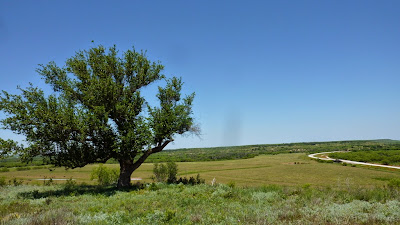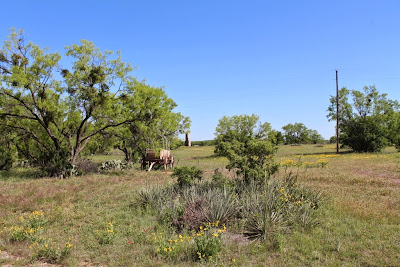Brief History
After the Mexican War the new Republic of Texas created a series of empresario arrangements to increase immigration into the newly established country. The desire was to spread settlement west and north into lands previously dominated by the Comanche, Kiowa, and Wichita and their primary sustenance, the buffalo. Beginning in 1849 a series of military posts were established in essentially three "waves" to protect settlers.
The first "wave" saw the establishment of seven stockaded posts from Ft. Worth on the Trinity River in the north, to Ft. Duncan on the Rio Grande in the south. According to Texas Beyond History the placement of these posts had two significant strategic flaws: they were too close to the settlements they were to protect, and were manned mostly by infantry troops unable to either effectively picket the communities or pursue the raiders.
Two years later saw the establishment of forts further "out" on the frontier: Fort Belknap, the furthest north (~80 miles NW of Ft. Worth on the Brazos), Fort Phantom Hill on the Clear Fork of the Brazos 80 miles SW of Belknap near modern day Abilene, and, 80 miles further SW on a branch of the Colorado River, Fort Chadbourne. These initially proved as ineffective as the first line of forts providing no real deterrent to the Comanche and Kiowa. In 1854 Texas authorized the creation of two reservations, one on the Brazos below Fort Belknap, and the other on the Clear Fork. Fort Phantom Hill proved unable to support itself with adequate water and was closed down shortly after it was established, and Belknap essentially became the caretaker of the reservations with responsibility of keeping the Indians in and the settlers out. At least until 1855.
The arrival of the 2nd Calvary in 1855, under the command of Col. Albert Sydney Johnston brought change to the plains and to the tactics employed. Shortly after, under the command of Col. Robert E. Lee, the 2nd was dispersed along a line of these "second wave" forts using them as bivouac, rendezvous, and supply points while ranging out onto the prarie scouting, intercepting and pursuing raiders as they found them. In a further expansion of tactics, expeditions into non-reservation tribal areas north of the Red River saw marked success.
During the Civil War the forts were primarily garrisoned by troops of the Frontier Regiment or, later, by the militia-style troops of the Frontier Organization. With most attention and resources focused north and eastward in the battles in Virginia, Tennessee, Georgia, and Missouri, the tribes became emboldened and, by the end of the Civil War, settlement on the frontier was tenuous, at best.
The third wave of forts came about as the result of the stationing of federal troops in Texas supporting Reconstruction and, ultimately, protecting citizens of the reconstructed United States along the frontier. The forts yielded better service than those previous installations, more due to tactics than strategy, their basic positioning within the "circle" of the second wave of posts. After Sherman "took off the cuffs" in 1871 they provided shelter and support for campaigns designed to end the frontier Indian problems once and for all.
The first "wave" saw the establishment of seven stockaded posts from Ft. Worth on the Trinity River in the north, to Ft. Duncan on the Rio Grande in the south. According to Texas Beyond History the placement of these posts had two significant strategic flaws: they were too close to the settlements they were to protect, and were manned mostly by infantry troops unable to either effectively picket the communities or pursue the raiders.
Two years later saw the establishment of forts further "out" on the frontier: Fort Belknap, the furthest north (~80 miles NW of Ft. Worth on the Brazos), Fort Phantom Hill on the Clear Fork of the Brazos 80 miles SW of Belknap near modern day Abilene, and, 80 miles further SW on a branch of the Colorado River, Fort Chadbourne. These initially proved as ineffective as the first line of forts providing no real deterrent to the Comanche and Kiowa. In 1854 Texas authorized the creation of two reservations, one on the Brazos below Fort Belknap, and the other on the Clear Fork. Fort Phantom Hill proved unable to support itself with adequate water and was closed down shortly after it was established, and Belknap essentially became the caretaker of the reservations with responsibility of keeping the Indians in and the settlers out. At least until 1855.
The arrival of the 2nd Calvary in 1855, under the command of Col. Albert Sydney Johnston brought change to the plains and to the tactics employed. Shortly after, under the command of Col. Robert E. Lee, the 2nd was dispersed along a line of these "second wave" forts using them as bivouac, rendezvous, and supply points while ranging out onto the prarie scouting, intercepting and pursuing raiders as they found them. In a further expansion of tactics, expeditions into non-reservation tribal areas north of the Red River saw marked success.
During the Civil War the forts were primarily garrisoned by troops of the Frontier Regiment or, later, by the militia-style troops of the Frontier Organization. With most attention and resources focused north and eastward in the battles in Virginia, Tennessee, Georgia, and Missouri, the tribes became emboldened and, by the end of the Civil War, settlement on the frontier was tenuous, at best.
The third wave of forts came about as the result of the stationing of federal troops in Texas supporting Reconstruction and, ultimately, protecting citizens of the reconstructed United States along the frontier. The forts yielded better service than those previous installations, more due to tactics than strategy, their basic positioning within the "circle" of the second wave of posts. After Sherman "took off the cuffs" in 1871 they provided shelter and support for campaigns designed to end the frontier Indian problems once and for all.
Pulled out early Wednesday morning, April 29th to visit my friends Bill and Martha B. in Tolar, TX.
Sort of jogged around Tomball and stopped at the Magnolia Cafe in Magnolia for breakfast. Took FM-1774 to SH-105 at Plantersville, then U.S. 6 out of Navasota to Meridian. From Meridian I took SH-144 through to Glen Rose and then local Hill City Highway outside of Glen Rose to Tolar.
A few scenery shots along U.S. 6 west of Waco. (Click to enlarge)











































